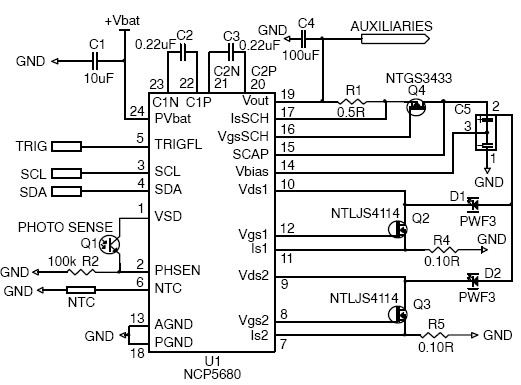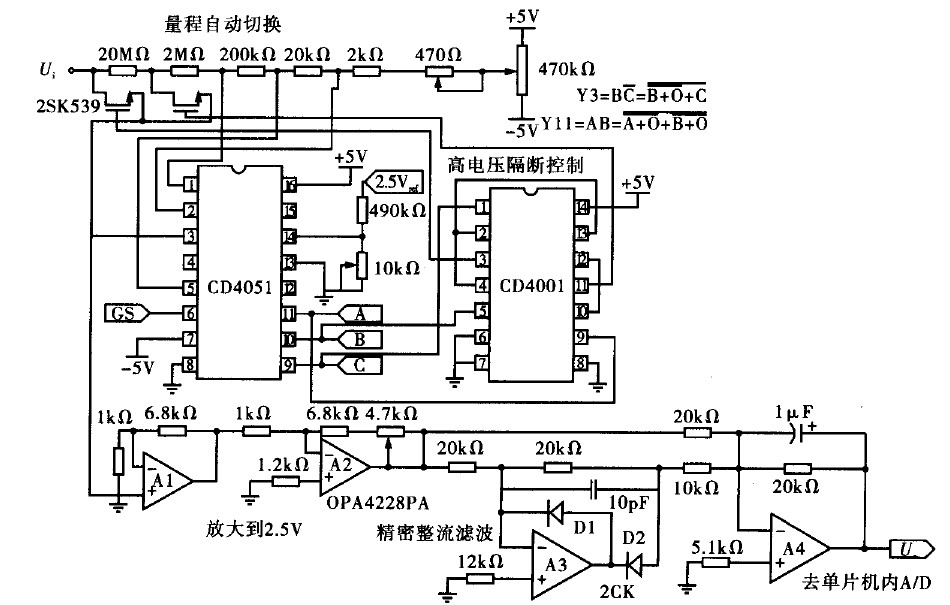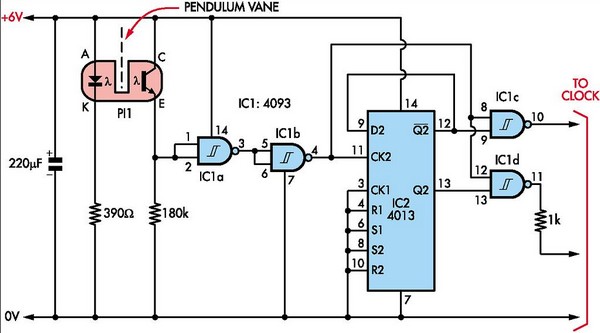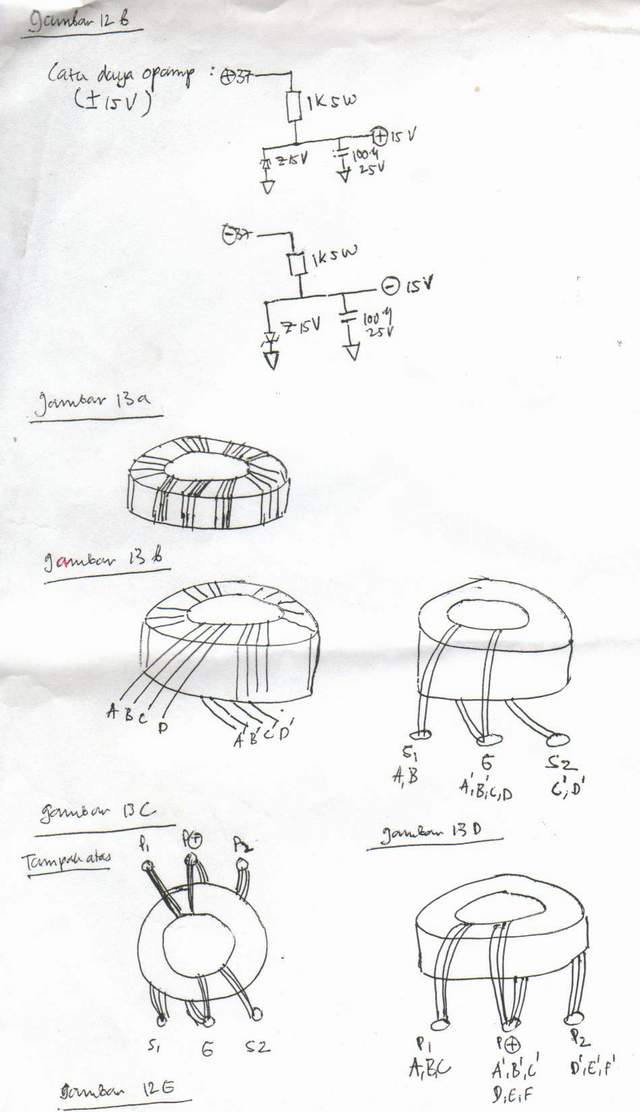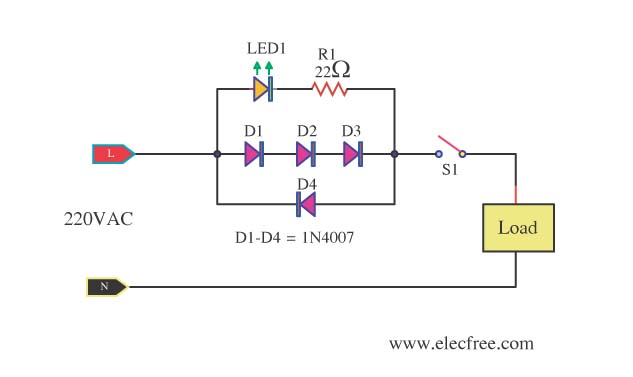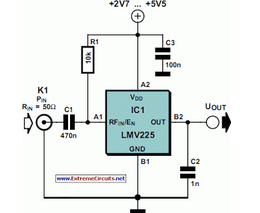
stereo led power vu meter
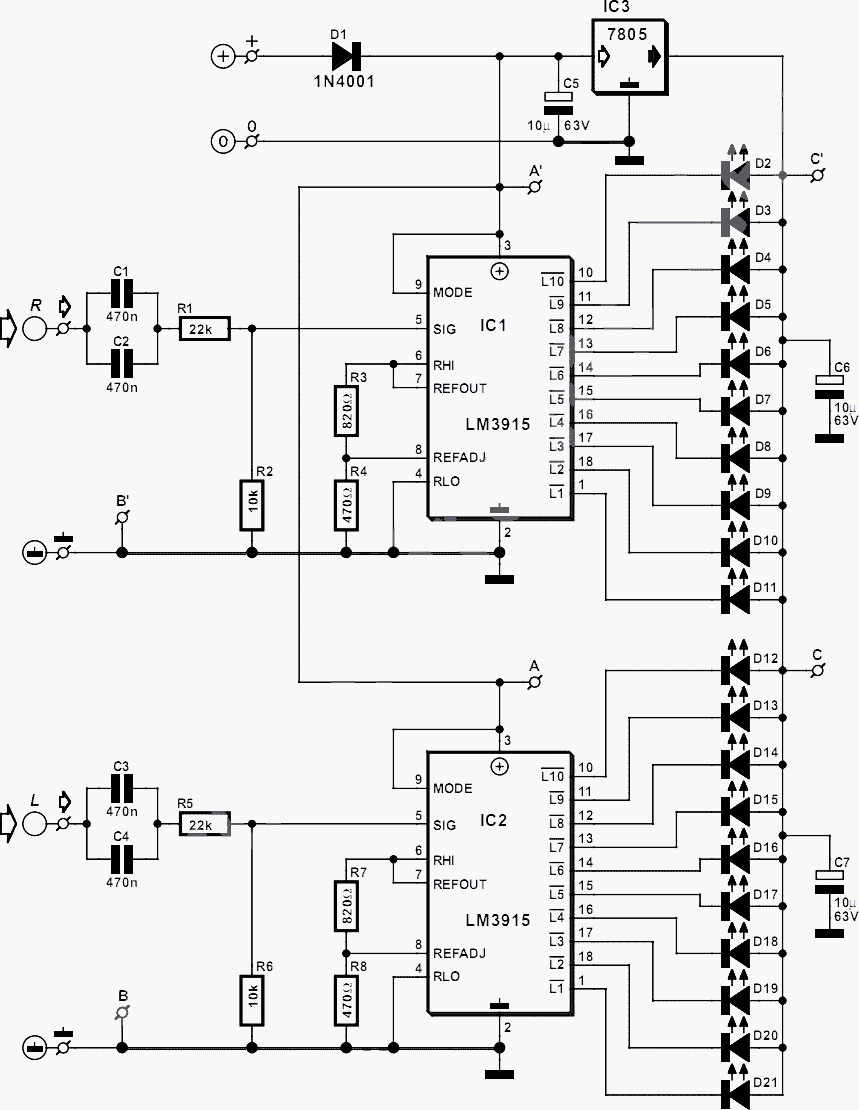
This circuit detects the AC audio voltage supplied to car radio loudspeakers and visually represents it as power using an LED bar graph, creating an appealing visual effect. It is designed to accommodate typical car radio output power ranges but can be easily adapted for different applications. The circuit operates from the 12 V car electrical system and is compatible with both Capacitor-Coupled (CC) and Bridge Tied Load (BTL) amplifier types without altering the circuitry or connections. The LED indications differ between the two types; for BTL, the LED increments represent four times the CC value for the same load. CC-type amplifiers connect the loudspeaker via a DC-decoupling capacitor to the output and ground (negative), while BTL-type amplifiers couple the loudspeaker directly between two equal, parallel, but phase-reversed outputs. This configuration results in a voltage swing that is double that of CC, effectively quadrupling the power supplied to the same loudspeaker load. It is essential to identify the amplifier type connected to the circuit to accurately assign power levels (W) to the LEDs. CC-type amplifiers have no DC voltage present at the outputs and return wires, which are linked to a common ground (negative). Conversely, BTL-type amplifiers exhibit approximately Vcc/2 at the outputs and return wires, eliminating the need for DC-decoupling capacitors. The LM3915N integrated circuit, which has been extensively covered in various publications, is utilized in this circuit as a LED bar graph driver (with pin 9 connected to pin 3). Both ICs share the same power supply. The audio input signal is routed through network components C1/C2, R1, R2 (and C3/C4, R5, R6) to pin 5 of IC1 (IC2), processing only the positive half-waves. The buffered input voltage is internally compared using comparators against voltages along a resistor ladder network. A nominal +1.25 V reference voltage (between pins 7 and 8) is applied across R3 (R7) to set the LED current, which flows through R4 (R8) to achieve the desired reference voltage between pin 7 and ground. A voltage of only 2.0 V is generated, allowing compatibility with low power amplifiers. This voltage is applied to the top of the on-chip resistor array (pin 6), setting the threshold for the LED connected to the L10 output. The low side of the array (pin 4) connects to ground, resulting in all LEDs illuminating for input voltages equal to or greater than the voltage at pin 6. Input voltages below the threshold for the lowest LED (89.3 mV or 27 dB below the top LED) will turn off all LEDs. To limit power dissipation in IC1 and IC2, the LED voltage is reduced to +5 V using IC3, C6, and C7. Diode D1 safeguards the circuit against reverse polarity. For a dot mode graph, pins 9 of IC1 and IC2 should be left open. With the specified value for R1 (R5), the indicator range accommodates audio power levels of 10 W into 4 ohms (CC) or 40 W into 4 ohms (BTL). Each subsequent lower LED indicates half the power of the preceding higher LED. Only R1 (R5) requires adjustment for different power levels, which can be calculated using the formula R1 = [R2 (PO ZL) / (k * VRefOut)] R2, where PO is the maximum output power to be indicated (LED D2 or D12), ZL is the loudspeaker impedance, R2 equals R6, VRefOut is 2.0 V, and k is a constant (2 for BTL, 1 for CC). The condition (PO ZL) / (kVRefOut) must be greater than or equal to 1. A compact printed circuit board has been designed for constructing a stereo version of the power indicator. The board can be divided into two sections to separate the channels and may be assembled in a sandwich configuration with three inter-board connections (A-A', B-B', and C-C') made using stiff wire. It is recommended to secure IC3 to a small heatsink (10 K/W).This circuit senses AC audio voltage supplied to the car-radio loudspeakers and displays it as power using a LED bar graph, achieving at the same time an attractive visual effect. It is designed to cover common car-radio output power ranges, but can easily be modified to suit different needs.
It is supplied from the 12 V car electrical system and is suitable for classical CC (Capacitor-coupled) as well as BTL (Bridge Tied Load) types of amplifier with no changes to the circuitry or connections at all. In fact, only the meaning of the LEDs changes ” with BTL, the LED increments equal four times the CC value on the same load.
CC-type amplifiers have the loudspeaker connected via a DC-decoupling capacitor at the output and ground (negative). BTL-type amplifiers, on the other hand, have the loudspeaker DC-coupled and stretched` between two equal, parallel, but phase-reversed outputs.
The result compared to CC` is twice the voltage swing, hence quadrupling the power being fed to the same loudspeaker load. It is necessary to know to which of the two types this circuit is connected to only in order to correctly assign power levels (W) to the LEDs.
CC-type have no DC voltage to ground at the outputs and return wires. The return wires are actually connected to the common ground (negative). BTL-type have approximately Vcc/2 at outputs and on the return wires too, explaining at the same time why no DC-decoupling capacitors are needed. The LM3915N integrated circuit used in this circuit has been the subject of numerous publications in this magazine so will not will not be discussed again.
In this application, the two LM3915Ns are configured as a LED bar graph drivers (pin 9 connected to pin 3), The ICs share the same power supply section. The audio input signal is fed via network C1/C2, R1, R2 (C3/C4, R5, R6) to pin 5 of IC1 (IC2). Only positive half-waves are processed by the ICs. Internally, the buffered input voltage is compared using comparators to the voltages along a resistor ladder network.
The nominal +1. 25 V reference source voltage (between pins 7 and 8) is applied across R3 (R7) to program the LED current. The programming current flows through R4 (R8) to achieve the desired reference voltage between pin 7 and ground.
Here, only 2. 0 V is developed, allowing this circuit to be used with low power amplifiers too. This voltage is applied to the top` of the on-chip resistor array (pin 6) and so determines the threshold at which the LED connected to the L10 output comes on. The other (low) side of the array (pin 4) is connected to ground. So, for an input voltage equal to or greater than the voltage at pin 6, all LEDs are on. At input voltages below the threshold set up for the lowest LED (89. 3 mV or 27dB below the top LED) all LEDs are off. In order to limit power dissipation of IC1 and IC2, the LED voltage is stepped down to +5 V using IC3, C6 and C7.
Diode D1 protects the circuit against reversed polarity. If a dot` mode graph is preferred pins 9 of IC1 and IC2 should be left open circuit. Using the listed value for R1 (R5), the indicator range covers audio power levels of 10 W into 4 (CC) or 40 W into 4 (BTL). Each lower LED indicates half the power of the previous higher` LED Only R1 (R5) needs to be redimensioned for different power levels.
The value can be calculated from R1 = [R2 (PO ZL) / (k * VRefOut)] R2 where PO = maximum output power to be indicated (LED D2 or D12) ZL = loudspeaker impedance R2= R6 VRefOut = 2. 0 V k = constant; 2 for BTL, 1 for CC The condition (PO ZL ) / (kVRefOut) ‰¥ 1 must be met. A small printed circuit board has been designed to allow a stereo version of the power indicator to be built.
The board is cut in two to separate the channels. The boards may be assembled in a sandwich construction with three inter-board connections A-A`, B-B` and C-C` made in stiff wire. IC3 should be secured to a small heatsink (10 K/W). Rectangular-face 🔗 External reference
It is supplied from the 12 V car electrical system and is suitable for classical CC (Capacitor-coupled) as well as BTL (Bridge Tied Load) types of amplifier with no changes to the circuitry or connections at all. In fact, only the meaning of the LEDs changes ” with BTL, the LED increments equal four times the CC value on the same load.
CC-type amplifiers have the loudspeaker connected via a DC-decoupling capacitor at the output and ground (negative). BTL-type amplifiers, on the other hand, have the loudspeaker DC-coupled and stretched` between two equal, parallel, but phase-reversed outputs.
The result compared to CC` is twice the voltage swing, hence quadrupling the power being fed to the same loudspeaker load. It is necessary to know to which of the two types this circuit is connected to only in order to correctly assign power levels (W) to the LEDs.
CC-type have no DC voltage to ground at the outputs and return wires. The return wires are actually connected to the common ground (negative). BTL-type have approximately Vcc/2 at outputs and on the return wires too, explaining at the same time why no DC-decoupling capacitors are needed. The LM3915N integrated circuit used in this circuit has been the subject of numerous publications in this magazine so will not will not be discussed again.
In this application, the two LM3915Ns are configured as a LED bar graph drivers (pin 9 connected to pin 3), The ICs share the same power supply section. The audio input signal is fed via network C1/C2, R1, R2 (C3/C4, R5, R6) to pin 5 of IC1 (IC2). Only positive half-waves are processed by the ICs. Internally, the buffered input voltage is compared using comparators to the voltages along a resistor ladder network.
The nominal +1. 25 V reference source voltage (between pins 7 and 8) is applied across R3 (R7) to program the LED current. The programming current flows through R4 (R8) to achieve the desired reference voltage between pin 7 and ground.
Here, only 2. 0 V is developed, allowing this circuit to be used with low power amplifiers too. This voltage is applied to the top` of the on-chip resistor array (pin 6) and so determines the threshold at which the LED connected to the L10 output comes on. The other (low) side of the array (pin 4) is connected to ground. So, for an input voltage equal to or greater than the voltage at pin 6, all LEDs are on. At input voltages below the threshold set up for the lowest LED (89. 3 mV or 27dB below the top LED) all LEDs are off. In order to limit power dissipation of IC1 and IC2, the LED voltage is stepped down to +5 V using IC3, C6 and C7.
Diode D1 protects the circuit against reversed polarity. If a dot` mode graph is preferred pins 9 of IC1 and IC2 should be left open circuit. Using the listed value for R1 (R5), the indicator range covers audio power levels of 10 W into 4 (CC) or 40 W into 4 (BTL). Each lower LED indicates half the power of the previous higher` LED Only R1 (R5) needs to be redimensioned for different power levels.
The value can be calculated from R1 = [R2 (PO ZL) / (k * VRefOut)] R2 where PO = maximum output power to be indicated (LED D2 or D12) ZL = loudspeaker impedance R2= R6 VRefOut = 2. 0 V k = constant; 2 for BTL, 1 for CC The condition (PO ZL ) / (kVRefOut) ‰¥ 1 must be met. A small printed circuit board has been designed to allow a stereo version of the power indicator to be built.
The board is cut in two to separate the channels. The boards may be assembled in a sandwich construction with three inter-board connections A-A`, B-B` and C-C` made in stiff wire. IC3 should be secured to a small heatsink (10 K/W). Rectangular-face 🔗 External reference
